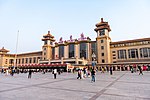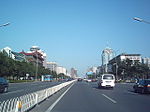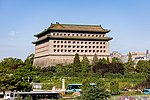Beijing Ancient Observatory

The Beijing Ancient Observatory (traditional Chinese: 北京古觀象臺; simplified Chinese: 北京古观象台; pinyin: Běijīng Gǔ Guānxiàngtái) is a pretelescopic observatory located in Beijing, China. The observatory was built in 1442 during the Ming dynasty, and expanded during the Qing. It received major reorganization and many new, more accurate instruments from Europeans (Jesuits) in 1644. As one of the oldest observatories in the world, the Beijing Ancient Observatory grounds cover an area of 10,000 square meters. The observatory itself is located on a 40 by 40 meter wide platform on the top of a 15 meter tall brick tower, an extant portion of the old Ming dynasty era city wall that once encircled Beijing. Several of the bronze astronomical instruments are on the platform, and other armillary spheres, sundials, and other instruments are located nearby at ground level. It is operated as a museum in affiliation with the Beijing Planetarium.
Excerpt from the Wikipedia article Beijing Ancient Observatory (License: CC BY-SA 3.0, Authors, Images).Beijing Ancient Observatory
Dongcheng District Jianguomen
Geographical coordinates (GPS) Address Nearby Places Show on map
Geographical coordinates (GPS)
| Latitude | Longitude |
|---|---|
| N 39.9061 ° | E 116.4281 ° |
Address
100010 Dongcheng District, Jianguomen
Beijing, China
Open on Google Maps








